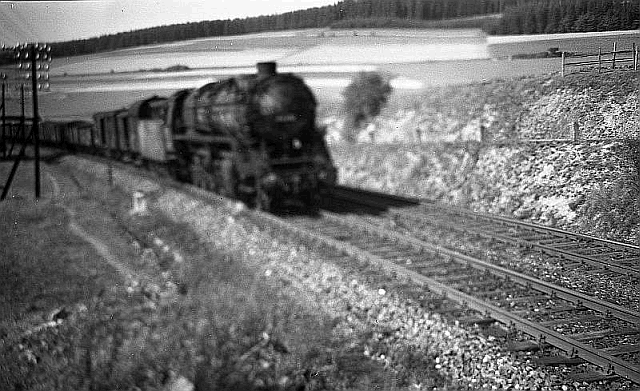
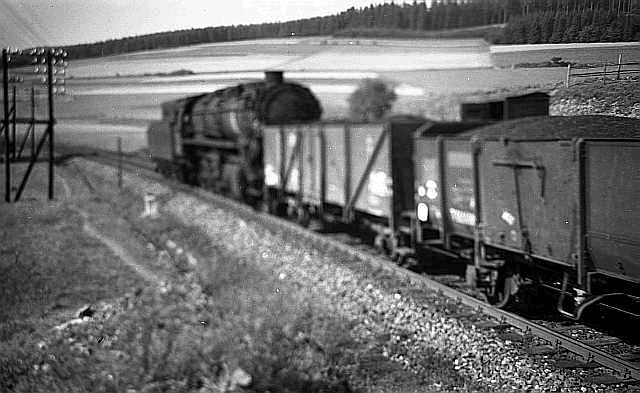
previous page (August 1946)
THE FINAL FIVE MONTHS
Four days
after our
return from Bückeburg, I went off on 27th August on my fifth and final
home leave, again via the Hook of Holland. I went by lorry to Münster and then
walked to the junction of the barracks siding with KBS 280 (Münster—Rheine)
and there saw several BR 50, 41, 03 and one BR 86. There was nothing noteworthy
on the journey next day across Holland except for 91.1054 and 55.3100 carrying
N.S. numbers at Hengelo; more commandeered locos. On return in late September, I
had to travel via Hull and Cuxhaven. Railway property there seemed intact but
the shed was unapproachable amid many sidings. A British Army families train
with several 12-wheel sleepers left behind 56.2375. A P8 and BR 50 went south
on fish trains. Next morning I decided that as I was on my own I would go via
Hamburg and so I left Cuxhaven at 0600 on a Flensburg train. At Neugraben was
another of the former Lübeck-Büchen double-decker push-pull trains with a
streamliner; 74.1318. In the yards at Wilhelmsburg, there were several of the
geared 0-10-0Ts of BR 87. I stayed overnight at the R.A.F. house in Blankenese
where I had been in August. Next day, I left on a military train from Altona to
Münster. As we paused in the Hbf. another train of covered vans carrying
‘Eastern refugees’ passed through going north behind 50.908 of Bw Lübeck.
Presumably the train had come out of the Russian Zone at Lübeck. Near Harburg,
we overtook the third of the Kriegsloks, 52.003 and in Celle was one of the
very last built of the P8s, 38.4016. There was nothing else out of the ordinary
until Bünde, near Löhne, where a Belgian 0-10-0, 9002 was lying dead. This
looked rather like a BR 57 taken by the Belgians after 1918. On the same shed
was a hefty 0-8-0T, 81.003; one of the small class built by the DRG in 1928
but not multiplied. A smaller version was the tiny BR 80, of which 80.014 is to
be found at Steamtown, Carnforth. At Osnabrück, we used the single track loop
north of the yards on KBS 270 (Löhne—Rheine) to reach the high-level platforms
on KBS 100 (Münster—Bremen—Hamburg). After an overnight at the barracks at
Münster, I hitch-hiked to Neheim, but had to spend yet another night there at
the transit house used by the local infantry, the Royal Scots Fusiliers. Next
day I went on by rail on P605 (Düsseldorf—Warburg) behind 38.3443. It was
packed so this time I climbed into the luggage van at the front to be greeted by
the unexpected sight of the Sergeant-Major of Royal Engineers from the local
railway control team.
We soon got into a deep and interesting conversation
about various railway matters. There was little progress on the Arnsberg viaduct
and he told me that the allocation of cement was quarterly only and was soon
used up. E342, the Kassel—Düsseldorf train which I had seen with a BR 01, had
gone back to six-wheelers and was worked on this occasion by a P8. Perhaps there
had been a failure because it was forty minutes late. The Sergeant-Major said
E342 now ran to München-Gladbach over the restored bridge at Neuss, This
final long winded journey had given me 146 new German locos; it lasted from
September 17th in Lancashire to the 23rd in Winterberg.
A few days later, I spent most of the day on KBS 350 at Olsberg. The line was very quiet with a total of 12 trains and one light engine. An east bound coal train with 44.492 and banked by 44.044 had a newly painted wagon lettered RAW Gotha, a works in the Russian Zone. It looked as if the bother about return of empty coal wagons had been sorted out. E342 still had only a P8 but the Prussian eight-wheel stock was back again. The P-trains also had P8s that day.
The Germans seem to be very fond of slogans and a platelayers hut near to where I was spotting had stencilled on its outside walls; 'Deine Arbeit gibt dem Rad die Sicherheit' — your work gives the wheel its safety. Somewhere else I saw another rather less apt slogan; 'Rader sen rollen für den Sieg' - wheels must roll for victory. In mid October I had my last lineside session at Olsberg and even less traffic was moving than earlier. Ten movements only were seen, including one banker returning light, with one loaded coal train and three westbound freight powered by BR44s. Three P8s were on P-trains and E342 had 01.215. Early in October, I picked up a copy of ‘Die Welt’, the principal post-war newspaper. A series of new long distance U- and FD- trains beginning on the 7th were reported. The ‘Nord Express’ ran now from Paris to Stockholm but via Bremen instead of Hannover. FD 191/2 ran from Köln Hbf. to Hamburg via Bremen and over either the Hohenzollern or Neuss bridges. The journey time was from 1025 to 1906 eastbound. Another FD pair ran between Köln and Ludwigshafen via Bonn, during the day southbound and overnight northbound, taking 5 hours and 28 minutes. There were four or five similar pairs of new expresses including one between Amsterdam and Berlin.
My final trip away from Winterberg, apart from two
short leaves in Germany, nearly ended in final disaster. I travelled with a sergeant
Air Gunner, now employed as a lorry driver, to collect rations from an Army depot
near Schwerte. Due to his reckless driving in overtaking a heavily loaded horse
drawn cart of logs on a bend, we were in a bad accident with a Volkswagen car
coming the other way. I I not been very quick my legs would have been crushed.
The lorry front was bashed right in and
we were stuck there at the roadside by the tunnel entrance for about two
hours before we could get a
lift and a tow. 01.181 went west on P342 but there were only four other movements. It was All Souls’ Day, November 2nd, and I too
nearly became one of the Holy Souls!
From 11th to 15th November, I was away on my own at Bad
Harzburg, the Army leave centre. We had an early morning start from the barracks siding at
Münster with 03.090 in reverse on M14. Apart from the normal locos there was nothing of interest until
Löhne, where
there was 17.235 on P514(Löhne-Osnabrück), and a red and cream 2-car D.M.U. , which ran between Bad Oeynhausen and
Köln for use of the Control
Commission, There was a meal halt of 35 minutes at Minden, in the style of Midland
days at Hellifield and Cudworth. At Hannover, another Baden Pacific, 18.316 ran
through light, our train changed engines to 41 .010 of Bw Hannover Ost for the
last stage to Hildesheim, Goslar and up to Bad Harzburg on KBS 240. For the final
11kms uphill we had a pilot, 38.3761 of Bw Goslar, arriving at 1347.
Next morning, I made straight for Goslar, rather naturally, but by road. This was a beautiful medieval town with no sign of war. The R.T.0. at the station, a Royal Engineers Sergeant, told me to go ahead and look round the station and shed. There were many BR93 anks for the very hilly branch lines on this side of the Harz mountains. The eastern side was, of course, in the Russian Zone. There BR 56 and 58 for local freights and at the carriage sidings, 53.7533, a former Czech 0-6-0 dating from the end of the last century, was heating coaching stock. I noted 31 locos; the foreman told me 45 locos were allocated with only 24 in working order. In the town I met a Corporal from the Manchester Regiment, my father’s old regiment from 1899 to 1922,; the first soldier from this regiment I had seen since leaving England in 1944. I travelled back up to Bad Harzburg on P1949(Goslar to Bad Harzburg) behind two P8s, 38.2099 of Bw Goslar and 38.2316 of Bw Hildesheim. After lunch at the leave centre, I went up the cable ropeway to the top of the Grosser Burgberg which over-shadows the town to the east. It rises 186m vertically in a distance of 481m and the journey took 3 minutes.
The weather was misty and with chilly winds. I had a footpath map, however, and set off along the eerie paths over the hilltop to see if I could see the Brocken, 1142m high over the Zone border. As the mists swirled to and fro, it could be clearly seen across a deep wooded valley, with its summit hotel tower just like the Kahler Asten at Winterberg. At. this point the path was blocked by a light wood and wire fence bearing a rather intimidating notice in English, French and German, warning walkers to go no further because of the danger of being shot. I should imagine there is more than a light wood fence at that point today.
Down in the town once again, I
noticed that one of the earliest of the P8s was standing in the station;
38.1020 of Goslar shed. Its tender still carried the former Prussian Railway
number on the tender side, 2202. While I was down in that part of the town, 56.2153
from Bw Borssum came off the Eckertal branch with a short freight. This
stub line 8.5km long , still carried early morning and evening passenger workings
each way. It was the remnant of a line across the northern part of the Harz to
Halberstadt and the east.
It was a very pleasant short break, and an unexpected
one, in a very beautiful district but it was gloomy indeed in November 1946.
M13, the return train to Münster left on the fourth day at 1620 behind
93.1081 piloting 01.021 of Bw Hannover Ost. It was dark from Goslar and I only
recorded ten locos for the whole journey back to Münster. I travelled the whole
way in the luggage van with the guard, chatting about railways. He gave me full
information about military trains passing through his division, RBD Münster,
and these are summarised below. I took the detailed times of both journeys to
and from Bad Harzburg and our best start to stop speeds were 41.9mph between
0snabrück and Löhne,
39.7mph
between Münster and Osnabrück and on the return 39mph Goslar to Hildesheim and a
breath taking 45.7mph between Hannover and Bückeburg. We changed engines at
Hannover to 41.010 and again to 41.290 at Osnabrück reaching Münster at 2246.
|
MILITARY TRAINS PASSING THROUGH RBD MUNSTER NOVEMBER 1946 |
|
M1/2
Hannover—Osnabrück—Hook of Holland and return
M3/4 Marienthal (Münster barracks sidings)—Münster Hbf.—Rheine— Hook of
Holland and return M5/6
Hannover—Hook of
Holland (ran only when needed)
and return M9/10
Cuxhaven—Neugraben—Münster—Ruhr district—Krefeld
and return M13/4 Bad Harzburg—Münster(every four days) and
return Ml9/2O
Hannover—Münster—Krefeld—Brussels and
return M21/2
Osnabrück—Hamm—Holzwickede—Bestwig—Winterberg
and return M3/9 took passengers from M1O/M4 at Münster Hbf. M14/21 ran Mondays
and Thursdays only M13/M22 ran on Thursdays and Sundays only M21 arrived at Winterberg 1444. M22 left WInterberg 1550 The Winterberg trains were to serve the Kurhaus Hotel for Winter sports leave, and possibly during the rest of year for general troop leaves similar to Bad Harzburg. It had only just started as a centre and of course, lorry or bus travel was out of the question for this kind of leave centre in 1946. |
I spent the morning and early afternoon of the next day spotting near the south side junctions at Münster where the Ruhr district direct line via Haltern (KBS 320) begins. The usual lines of derelicts were found here but there was plenty of traffic going in and out of the yards south of the Hbf. The freights were in sole charge of BR 50s and 52s from Münster, Recklinghausen , Gelsenkirchen-Bismark, Wanne-Eickel and Hamm sheds. FD191 from Köln went north to Hamburg behind 03.218 of Bw Osnabrück Hbf. This was certainly an improvement on anything for internal civilian travel I had seen previously, with eight standard corridors, 2nd and 3rd class, and a luggage van. There were no wooden-boarded windows, nor was the train so crowded as usual. Ever since then, I have thought of this train as the first sign of real recovery I saw in the country which so blossomed in 1948 and 1949. I returned to the barracks in mid afternoon and left for ‘home’ in one of our trucks; the Winterberg direct train did not run on Fridays and I didn’t fancy a journey in semi-darkness in a crowded P-train.


44.492 heads a coal train up-grade at Olsberg...........and is banked by 44.044 on 28th September 1946
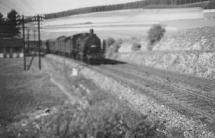
38.2653 at Olsberg on an eastbound P-train on 28/9/46
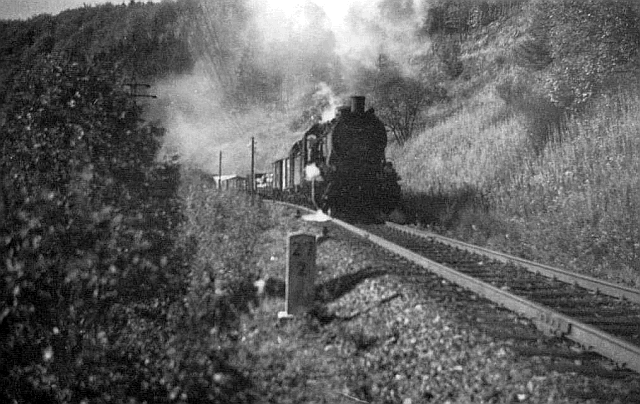
57.2687 in the Nuhnetal south of Winterberg on a Frankenberg to Winterberg freight on 11th October 1946.
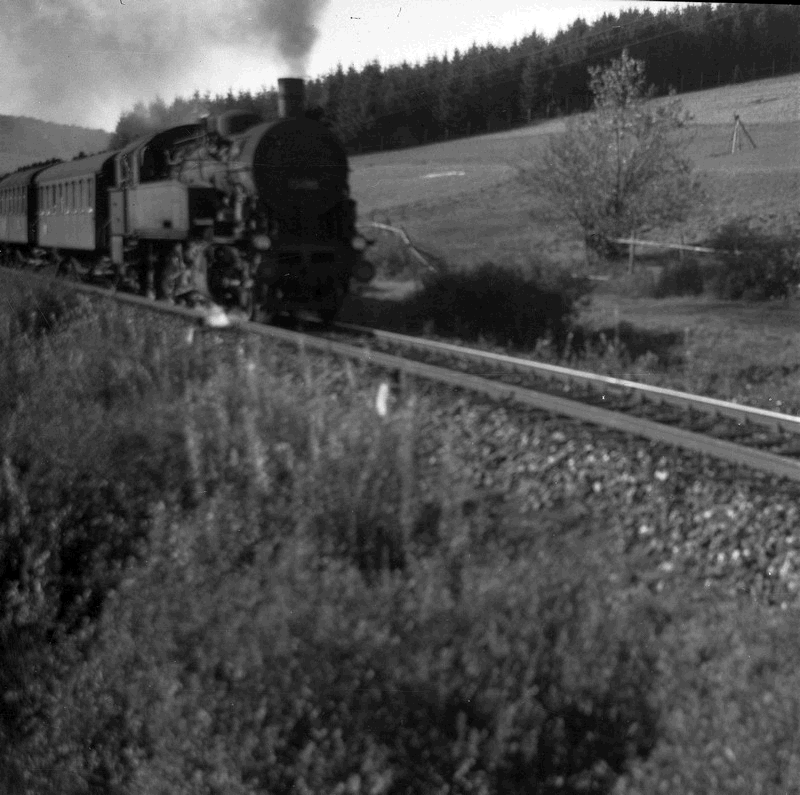
A BR 93 heads P1498 from Frankenberg to Winterberg south of Winterberg on 11/10/46
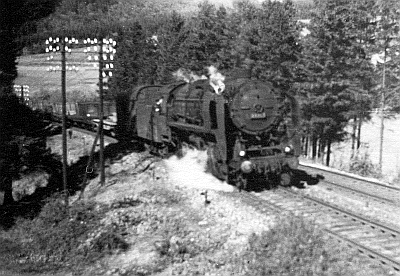
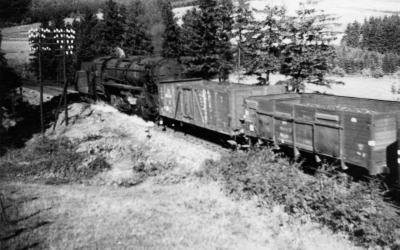
44.703 is seen east of Olsberg being banked by 44.429 on the 12th October 1946
`1`1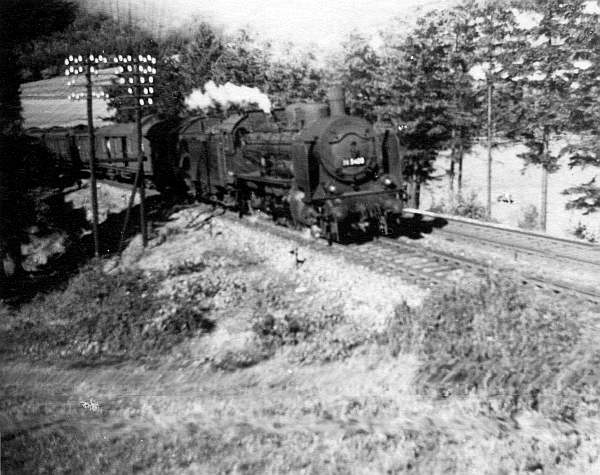
38.3428 is on train P605 from Düsseldof to Warburg on the 12th October 1946
next page (January 1947)